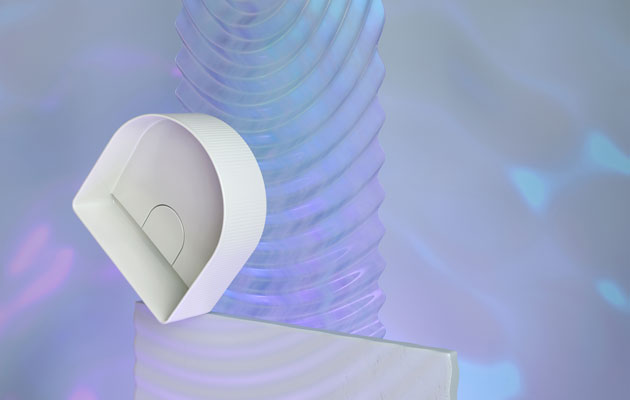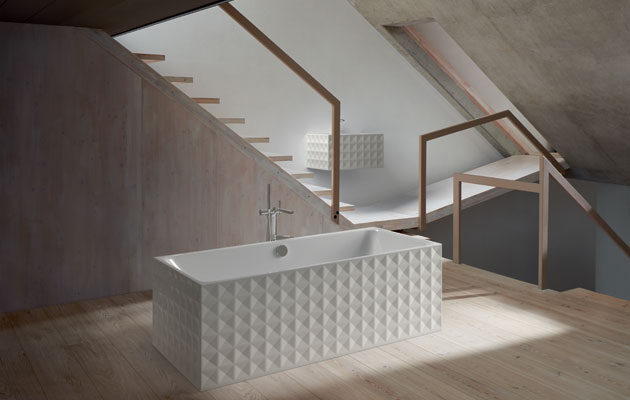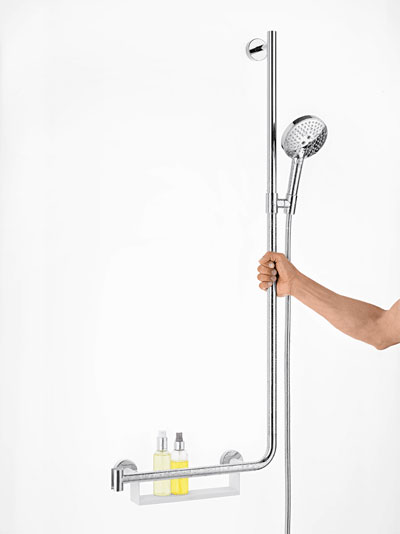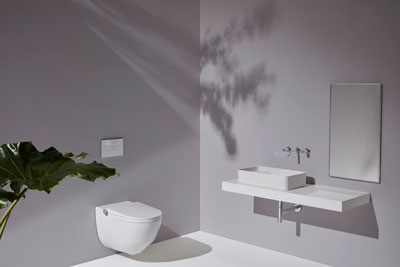|
|
||
|
The sanitaryware and HVAC trade show in Frankfurt revealed that bathroom companies are trying to broaden their appeal, reports Peter Smisek The Internationale Sanitär- und Heizungsmesse, the large sanitary and HVAC trade show also known as ISH, once again took over Frankfurt’s sprawling convention centre in March. While the ubiquity of the water-closet and the bathroom in today’s European and American households, and the large scale infrastructure that enabled it, must surely be the most successful public health intervention of the past century – all but eliminating water-borne diseases that plagued the industrial city – sanitaryware is somewhat absent from the pages of today’s design magazines. Perhaps there’s a feeling that the battle has been won, and all that’s left now is to obsess about experience, luxury and styling.
Ornament by Bette It is true that the modernist mantra for the bathroom was health, hygiene and efficiency. Even wealthy industrialists, who would commission the likes of Adolf Loos or Ludwig Mies van der Rohe to design their opulent villas, were content with rather Spartan white tiles and stainless steel. The apotheosis of this approach is surely Buckminster Fuller’s 1936 Dymaxion bathroom, a moulded aluminium design – its progeny today is found in aeroplane lavatories. It is difficult to imagine the moneyed classes and high-end hotels commissioning these spaces today. But it would be unfair to dismiss modernism as a wholly unemotional affair – after all, the bathroom in Le Corbusier’s Villa Savoye was a wonderfully layered space, with a sit-down bathtub, a tiled recliner and sweeping views of the outside. It is this individualistic and more holistic approach to cleaning – one that is about more than just washing away the dirt – that is currently gaining the upper hand.
Axor showers That said, brassware and ceramic manufacturers are still keen to stress the relationship between their latest products and their primary function. Hansgrohe and Axor (Hansgrohe’s high-end counterpart) have been steadily introducing a series of no-touch taps that help eliminate the spread of pathogens. The German manufacturers also managed to skilfully integrate safety shower bars and handles into its range. Combining these with, for instance, Axor One, an accessible shower control panel designed by Barber and Osgerby in 2015, means the space can be fitted out to conform to disability access regulation. Dornbracht has also embraced this trend and introduced a series of no-touch taps, whose sensors are discreetly hidden within the sanitaryware or cabinets. More technically oriented manufacturers, such as Viega, have taken on the manufacture of systems for height-adjustable basins and toilet bowls. And although these products were available on the market before, their integration with high-end fittings represents a step towards their normalisation of technologies formerly relegated to the medical sector.
Unica Comfort set by Hansgrohe Of course these developments, while unlikely to be picked up by the average consumer, are appealing to hotels, more demanding private clients and developer for the obvious reason of being able to offer more possibilities while not having to buy a host of different products to suit everyone’s needs.
Riva Cleanet set by Laufen But there were some developments, which excited this journalist, and might even appeal to the consumer market. For starters, Japan-style washlets finally made it to Europe. At least three major continental ceramic brands – Roca, Laufen and Duravit – have introduced new designs that incorporate the technology in a visually unobtrusive way. Compare this to the wares presented by the famed Japanese manufacturer Toto, a world leader in the field, which resemble ovoid spaceships, and which do little to help endear these seemingly ‘foreign’ contraptions to an audience of conservative-minded British consumers (case in point: bidet, that fixture of continental bathrooms, has still not been normalised in the UK). Then there were gimmicks and prototypes, such as Duravit’s smart toilet, which can take readings of its users’ urine and deliver them to a tracker app. While the pitch seemed to be delivered through semi-aspirational imagery aimed at the general audience (and undoubtedly visiting journalists), such devices could, theoretically, be useful in clinics and health facilities. Patterned brass tap by Gessi Another unavoidable trend was the large range of colour and material options now available in brassware. Bathrooms are becoming an inhabitable milieu, meaning designers and clients now demand a range of surface treatments for their taps. The colours on offer are the usual suspects – bronze, rose gold, copper, brushed gold – although blackened steel seems to be the only one not yet prominently seen in other design categories. Texture is also making inroads. For a long time, taps, surfaces and ceramics, not matter what style, have been largely smooth or smoothened. The prime concern was hygiene: bacteria find it hard to cling onto smooth surfaces, and thrive in wet, warm crevices that clog up with limescale. Most textural flourishes are therefore reserved for parts that do not necessarily come into unrelenting contact with water, but feature on the outside. Laufen, for instance, introduced new prototypes of fluted basins by Patricia Urquiola called Sonar, and Gessi leads the pack with highly pattered brassware. Bette, after introducing a bath with upholstered sides last year (thankfully waterproof), has now come up with Ornament: a range of enamel-steel bathtubs and sinks with a gridded, waffle-like pattern adorning the sides. Perhaps the trend will trickle down over the years?
Luv by Cecilie Manz for Duravit It is also clear is that every manufacturer is trying to broaden their appeal: Hansgrohe for instance, which furnishes many a bathroom, is emphasising its range of kitchen taps and sinks, while Duravit expanded its ceramics range to offer a basic range of taps and mixers. Axor introduced a range of showerheads with a wide stream, designed to emulate the sensation of the ever-popular waterfall massage devices commonly found on the side of a swimming pool. Of course, manufacturers are also keen to stress their design credentials, to differentiate themselves from their competitors, as well as tap into design narratives outside the bathroom. Apart from the aforementioned designers, Cecilie Manz designed a new range, Luv, for Duravit, and Rafael de Cárdenas and Neri & Hu were asked to design ‘material collages’ (essentially mood boards) for Dornbracht’s new, art deco-inspired Vaia tap. There were novel products and room-sized shower systems that one would either find in a high-end wellness hotel, or perhaps in the deep basements of Knightsbridge townhouses. Time will tell whether these will catch on and be scaled down for the masses or remain an excusive plaything for the rich. In any case, while there may not have been any revolutionary revelations at this year’s ISH, there’s still plenty to write home about. ISH, 12–13 March 2017, Messe Frankfurt – A selection of products from the fair will be exhibited at CP Hart Waterloo from 11 May |
Words Peter Smisek
Above: Sonar by Patricia Urquiola for Laufen |
|
























